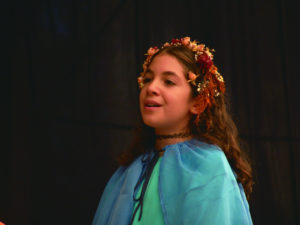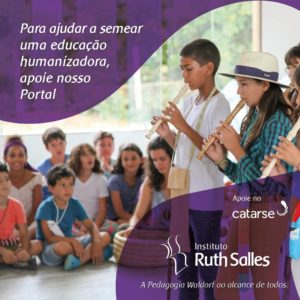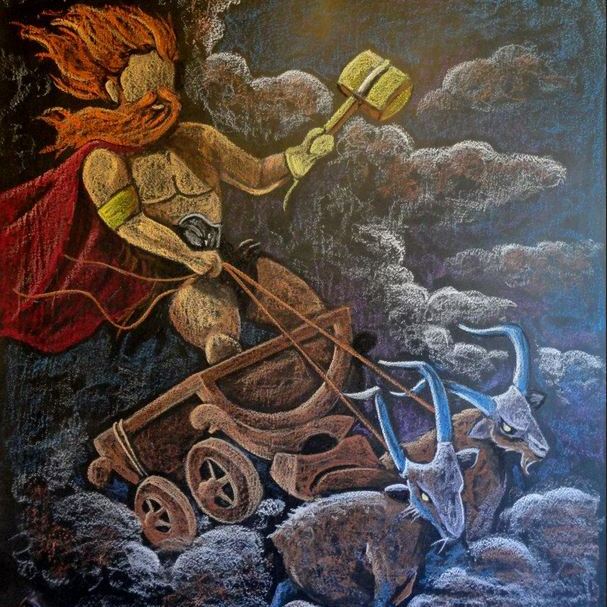 The 10 year old child
The 10 year old child
By Cristina Maria Brigagão Abalos, Dora Regina Zorzetto Garcia and Vilma Lúcia Furtado Paschoa.
By the age of 10, almost all children have already gone through the phase of being estranged from the world, resulting from the disappearance of the feeling of unity and integration with nature and the environment, which prevailed until around the age of 9; they now glimpse their own individuality and begin to develop a more harmonious phase, which should last until approximately the age of 12. These children want to be here and now; very healthy and active, they feel great enthusiasm and curiosity for everything that is presented to them.
The rhythmic wheel, so used with younger children at the beginning of each day, to harmonize them and prepare them for learning, undergoes transformations. The rhythmic exercises* are now performed in the frontal position: either with the whole class facing the teacher, or one half facing the other half, etc.
We suggest that the contents of the subjects be given with many descriptions, very rich and colorful; students often ask a lot of questions and add information that they themselves have or discover. In this age group, it is necessary to characterize each content brought before conceptualizing it. No scientific dissection should be done, which would dry out any experience.
One of the ways of accessing the feelings of children of this age is Norse Mythology, a collection of stories with varied origins and transmitted orally until the 11th century in Scandinavia, when they were first written in verse. This collection is called Ancient “Edda” (the word “Edda” means ancestor woman or great-grandmother). Around AD 1200, Icelandic Snorre Sturlason writes the New "Edda", but in prose.
Through these stories, 10-year-olds can imaginatively penetrate some secrets of human existence: they are powerful images that healthily “shake” children and tell them about honor, courage, struggle and other fundamental values. The stories, touching your heart, translate the shift in consciousness they are going through. The image of Norns, for example, draws attention to the passage of time, to the existence of the past, the present and the future, which only now the child is able to understand in depth. In the context of these images, the teacher can work on verb tenses. In Siegfried's story, the hero must forge his own sword, defeat the dragon and free the young woman imprisoned by fire: these are beautiful images that have already appeared, in a simplified form, in fairy tales, but which now, in a new guise, speak of the inner struggle that each child faces at this age, moving away from childhood towards their individual path, trying to overcome impulses and conquer a loving and balanced attitude towards the world.
Students at this age feel a strong attraction to animals, they want to know them, know how they live and what their specialties are. This approach is quite different from that taken with fables in previous years. Now, animals are described by observing their shapes and colors, movements and habitat, how they feed and how they protect themselves and, above all, their specialties. Children will find that man does not have a single specialty, but that he can contain them all in a less developed way. It is as if a little bit of each animal is gathered in the human being. By showing children animals in their relationship with man, the bridge between them and the world is rebuilt and understanding cultivated. When the child realizes the intertwining and interdependence that exists between all things in the world, he gains confidence and develops a social feeling.
For 10-year-olds, it is suggested that the study of Geography and History is still quite integrated. It can start with the place where the children live: they can be asked to observe and draw their house, the surroundings, the way to school and its surroundings; there is talk of the city where you live and that it was not always like this. What existed before the city appeared? Who lived here? How did the first navigators who arrived here come? What did they have to face? This whole subject is very extensive, but it can all be told as a story, without judgment. There will be occasion for this in the coming years!
Also this year, the systematization of grammar can be deepened and the study of grammar classes, experienced in previous years, is expanded. In mathematics, fractions come into play: it is only after perceiving himself separated from the world that the child understands fragmentation better.
THE THEATER FOR 10-YEAR-OLD CHILDREN
All these subjects can be dramatized, including Portuguese and Mathematics; we can do dramatizations about animals or landforms, a play about an indigenous legend or an episode of the population of our region, a dramatization about verbs or fractions, always with poetry, music, lots of movement and well-cared for speech.
With 10-year-olds, there may be more individualized roles and less chorus acting. More aware, secure and resourceful children are able to establish, sustain and develop dialogues between characters.
However, in the assembly process, everyone must experience the various roles in the play. The definition of these roles is up to the teacher who, due to his involvement and sensitivity, will be able to perceive both the student's real identification with the character and the pedagogical needs. Often, the experiences through a character can be the counterpoint to the student's harmonization. A fragile child, for example, can be the “cacique” of a play like the one suggested below and who, despite restricted speech, is an imposing figure, a leader.
In the scenarios, in addition to colorful cloths to compose environments, there may be scenic objects made by students in the Arts classes, promoting a more comprehensive curricular integration.
The costumes can also receive more details, characterizing the characters in a more detailed way, albeit using simple and low-cost materials, or making pieces that can be used in other dramatizations, gradually composing a small school dressing room.
As a practical example, the play “O Começo de São Paulo” was chosen, which is part of the proposal for an integrated teaching of History and Geography. The text, based on documents and letters of the time, presents peculiarities that enrich and expand the students' language. It also characterizes the universe of the indigenous, the Portuguese conquerors and the Jesuits, showing their interaction.
The scenic composition can have more than one plane. The choir, further back, is divided into different planes (which can be done with wooden platforms). In front, at first, there is nothing. Nóbrega comes from afar with Leonardo Nunes (it can even be from the middle of the audience). Indians arrive from different sides, bringing, for example, blue cloths, representing the Tamanduateí and Anhangabaú Rivers. Leaving the cloths on the ground, they leave, and Nóbrega, supported by a staff and guided by the young man André Ramalho, begins the “climb up the mountain”, indicating in gestures the physical effort that this requires. From time to time he stops, catches his breath, measures the distance with his eyes and admires the landscape. The choir speaks for Nóbrega. João Ramalho enters and some Indians arrive with their chiefs and a dialogue is established between them, from which they all begin the construction of the tent, which will be a school, kitchen, infirmary, cafeteria and dormitory. After that, following the lines, other characters enter, bringing objects from their work, for example: Anchieta carries a book and fibers to weave espadrilles; Paiva brings fabrics and containers for dyeing; Jácome threads wooden beads to make a rosary, etc. Gradually, the scenery is composed, leaving the center free so that everyone can build the altar together.
In addition to the songs that are part of the piece, which can also be worked on in the Arts class, all the movement must be accompanied by the sounds of rattles, rain sticks, reco-recos, whistles with bird sounds. Singing is always done by everyone. It would also be nice to introduce an indigenous dance and make a shell trumpet (snail), which is made by breaking its beak and sanding the hole. It is played through the vibration of the lips. This was the instrument that the natives used to give some warning, like a call to gather.
The costumes can be divided into three groups: the clothes of the Indians based on jute or straw and applications of feathers, seeds and shells, adornments on the arms, ankles and necklaces; the chiefs also wear a headdress; the Jesuit priests wear long black cassocks, with crucifixes hanging over their chests; Nóbrega can wear a wide-brimmed hat; the Portuguese will wear wide, rustic pants inside high boots (this can be simulated with pieces of leather, felt or suede paper), belts, long-sleeved shirts with vests, leather or felt hats with wide brims, something similar to the scouts' clothing. We suggest that the choir perform wearing robes of one or two colors.
* Rhythm exercises – Every day, when children arrive in the classroom, they come from different environments and present themselves in a special mood: some arrive breathless because they were late, others tired, because they were in a lot of traffic, others watched a fight between parents or even worse. They are not ready for learning. The main function of the rhythmic part is to harmonize these children and prepare them for learning. A poem, no matter how small and simple, said in chorus at the beginning of the school day, for example, helps to ease students' dispersion and make them feel that they are part of a whole. In a playful and joyful way, rhythm exercises are taught, with poetry and songs – which may even be part of a future play – performed by everyone, with claps, gestures, movement, “tuning” the class. This is how the body schema, spatiality, diction, attention, social integration and many other aspects are worked. This beginning of the class, which we call the rhythmic part, is repeated, in this way, for three or four weeks, when then something is changed, not all at once, that is, a poem is replaced by a new one, then a new one. music and so on, following the themes worked in class, the matter. In the long run, rhythmic work develops qualities and creates dispositions and skills for theatrical work.



